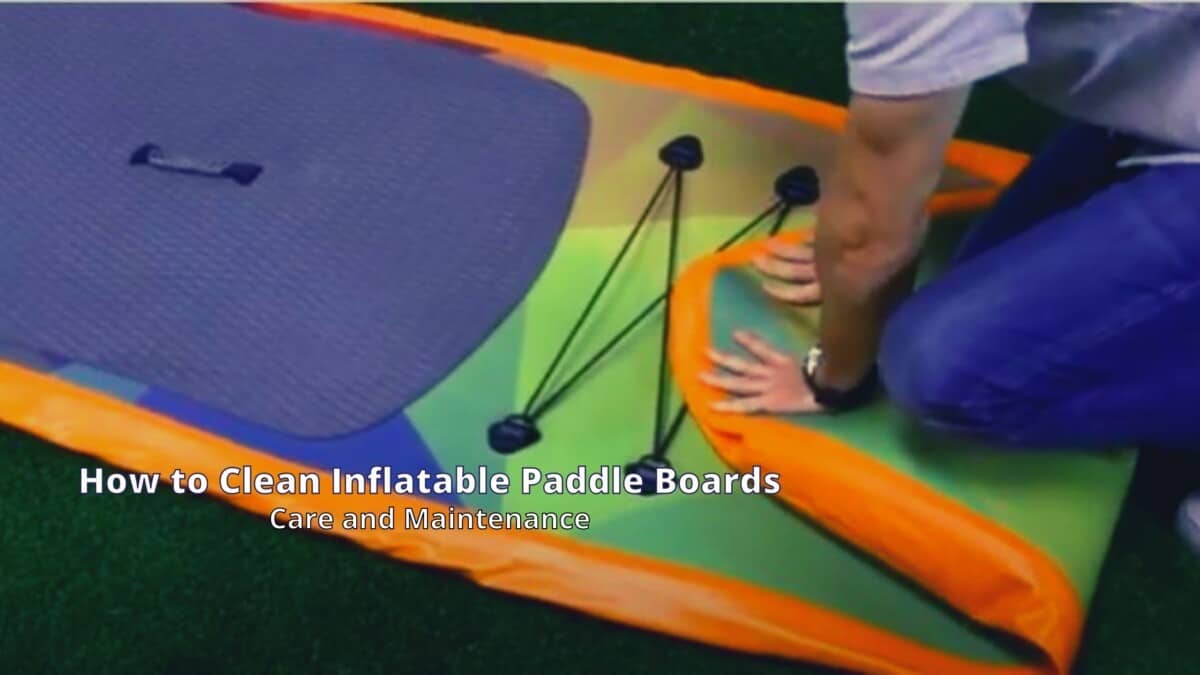Inflatable paddle boards can get dinged, scratched, and dirty over time. And in order to enjoy your time out on the water, you need to take good care of your gear. There are many ways to make your investment last longer, which include proper cleaning, making repairs, and properly storing it.
To clean your inflatable paddle board, you need to rinse it with fresh water, use a PVC cleaner, then rinse it again. Next, dry your board, and then store it. Doing this is really easy, but you need to know all the other factors to avoid damaging it and make your inflatable paddle board squeaky clean. Read along, so we can guide you through the steps on how to clean your inflatable paddle board.
If you are looking to buy an inflatable paddle board and are faced with too many choices or have no prior knowledge on how to select a board, we’ve got you covered. Read our article and check out our top recommendations of the best inflatable paddle boards.
Proper cleaning
First step: rinse
- Rinse your inflatable paddle board with fresh water to remove all the debris, gravel, and dirt.
- Note that when paddling on freshwater, you do not need to rinse your board after every use unless you want to get rid of dirt.
- If paddling in salt water, it is important that you rinse your board with freshwater to remove the salt because it may corrode the material and weaken the board’s seams over time.
- Rinsing your inflatable paddle board with fresh water will prolong its life.
Second step: clean
- To clean the PVC material on your inflatable paddle board, use any natural biodegradable cleaner.
- You can also use a simple natural soap or any mild cleaner that does not contain any chemicals.
- There are a lot of PVC cleaners on the market, which are environmentally friendly, non-abrasive, and can protect your board from UV rays.
- When cleaning the traction pad, scrub it very gently to avoid shredding the pad.
Third step: rinse again
- Using fresh water, rinse your inflatable paddle board again after cleaning, so that you can remove all the soap residue.
Fourth step: dry completely
- After cleaning your inflatable paddle board, you should let it dry completely before packing it away.
- If you paddle regularly, don’t worry about drying it every time.
- Dry the board with a towel before deflating and packing it away. Note that if you plan to store your board for a long time, it should be fully dried because leaving it wet will inspire the growth of bacteria and mold, and will weaken the seams. Plus, it will smell bad.
Stand up paddle boarding is one of many fun water activities that can also be a full-body workout. If you are a beginner, it is helpful to know a little bit about your gear and basic techniques before you head out on the water. Check out our paddle boarding tips for beginners to help you get started.
Storage
- Make sure the board is dry.
- Deflate it.
- Take off the fins.
- Roll it and pack it in its storage bag.
- Keep the bag stored away from direct heat, sunlight, and other elements that may damage the material.
Rolling technique
**Do not roll the board tightly
**Rolling the board loosely is better for the seams
- Inflate the board fully.
- Place the pump at the nose of the board.
- Start rolling the board beginning at the nose, so you can push the air out while doing so.
- This will also let the fins remain on the outside and fit nicely inside the bag.
- Once you are at the tail, grab your strap and clip it together, then tighten it.
Folding technique
- Lock your valve stem open to release the pressure.
- Fold the nose over at approximately 18 inches.
- Continue to fold until you reach the end.
- It is important to keep the area where the fins are located flat to avoid damaging or bending them.
- Store the board in the carry bag.
Leaving your board inflated
- You can leave your board inflated after each use and after cleaning it.
- Remember to store it away from debris, direct heat, and sunlight.
- Store it off the ground.
- Inflatable paddle boards lose air pressure over time, so it’s best to check the air pressure gauge when taking it out again.
Repairing tips
- Step 1: Apply water over the area to check for leaks. If you see bubbles, that means that air is escaping.
- Step 2: Deflate your board and properly clean the area where the leak is located.
- Step 3: Let it dry fully.
- Step 4: Apply glue to the leak liberally. This glue is included in the repair kit that most of the time comes with a paddle board.
- Step 5: Wait for about 20 minutes, and apply a second layer of glue.
- Step 6: Wait for another 20 minutes, and apply a third layer of glue.
- Step 7: Take the PVC patch, also included in the repair kit. Cut in a round shape, which is a little larger than the area of the leak.
- Step 8: Apply some glue to the patch and press it over the leak.
- Step 9: Keep pressing it for about 2 minutes and wipe the excess glue away. Apply pressure by using something heavy or a clamp.
- Step 10: Wait for 24 hours before inflating your board again.
Traction pad repairs
- If your traction pad peels off, simply glue it back.
- Add glue under the section of the pad that has come loose. This glue is included in the repair kit that usually comes with the board.
- Press down for 2 minutes.
- Leave for 24 hours before using your board again.
Other care tips
- Don’t drag your board over gravel.
- Try not to drop it on the ground.
- Do not sit on your board when the fin is on land.
An inflatable paddle board can withstand an adequate amount of abuse, but with added care and maintenance, it should last for more adventures.
If you do not have enough time to inflate and set up a stand up paddle board, then a non-inflatable paddle board may be your best choice. If you don’t know which one you should get, check out our top recommendations of the best non-inflatable stand up paddle boards.
FAQs
Are inflatable paddle boards worth the money?
Yes, inflatable paddle boards are worth the money and are great in terms of durability, versatility, portability, weight, and injury prevention. However, if you are planning to do some surfing or racing, it may be best to choose a non-inflatable board or hardboard.
How long does it take to deflate a paddle board?
It will take no more than 5 minutes to deflate a paddle board. Just let the air out, dry it off, roll it, then store it away.
How do I find out if my board has leaks?
When your board is fully inflated, pour some water over it and look closely for tiny bubbles that may form because of air pressure escaping.
Conclusion
If you want to enjoy paddle boarding for a long time and get your money’s worth, then you need to properly take care of your inflatable paddle board. This means that you have to maintain it regularly, ideally after each use. You also have to look out for holes and leaks in your board and patch them up immediately to prevent further damage.
Cleaning your equipment should be part of your paddle boarding routine, especially if you’re doing this activity in salt water. The guide that we provided should be enough to help you clean and store your inflatable paddle board correctly. We also shared some repair tips in case you run into some mishaps.

